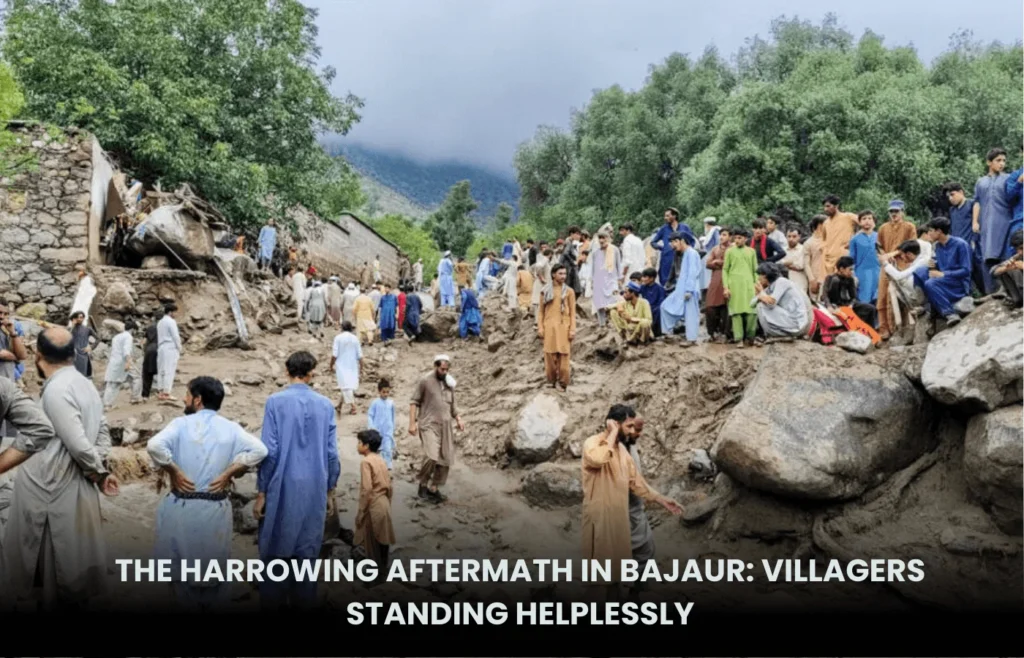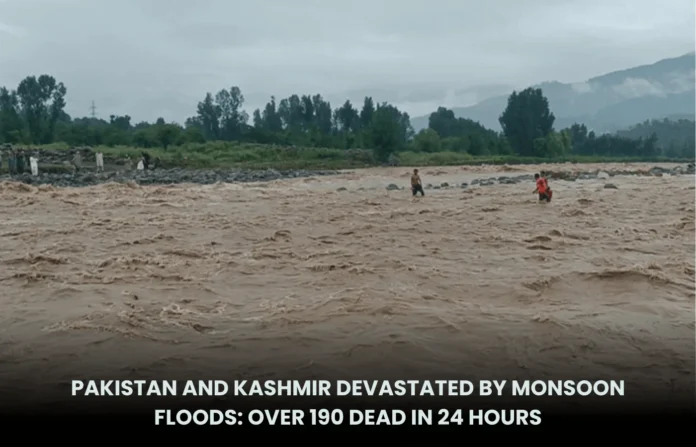Pakistan and Kashmir Devastated by Monsoon Floods: Introduction
In one of the deadliest spells of this year’s monsoon season, at least 194 people have died within 24 hours as relentless rains triggered widespread floods and landslides across Pakistan and Pakistan-administered Kashmir. Rescue agencies describe the situation as catastrophic, with entire villages submerged, homes swept away, and infrastructure crippled. Officials fear that the death toll will climb further as many remain trapped under debris or missing.
Khyber Pakhtunkhwa Bears the Brunt
The province of Khyber Pakhtunkhwa (KPK) in north-western Pakistan has emerged as the worst-hit region. Disaster authorities confirmed that 180 fatalities were recorded here alone, as gushing floodwaters and massive landslides swallowed homes and roads. At least 30 houses were destroyed outright, leaving families without shelter.
The disaster response was further hampered when an M-17 helicopter delivering relief supplies to Bajaur, a mountainous district bordering Afghanistan, crashed due to poor visibility and severe weather, killing all five crew members on board. The accident underscores the enormous risks faced by first responders working under treacherous conditions.
Rising Deaths in Kashmir and Gilgit-Baltistan
Elsewhere, nine deaths were reported in Pakistan-administered Kashmir and five more in Gilgit-Baltistan, where fragile mountain terrain makes communities especially vulnerable. Authorities have declared several districts disaster zones and deployed both military and civilian teams to assist survivors. However, with forecasters predicting heavy rainfall until 21 August, the possibility of further devastation looms large.
Survivor Testimonies: Fear Beyond Words
For locals, the disaster has been nothing short of apocalyptic. Azizullah, a resident of Buner, recalled the terror when floodwaters surged into his village:
“I heard a sound as if the mountain was collapsing. The earth trembled, water came rushing like a beast, and everything shook violently. It felt like doomsday — like death was staring me in the face.”

Image from Bajaur capture the harrowing aftermath: villagers standing helplessly as excavators dig through mud-soaked hills, while grieving families perform funeral prayers beside bodies wrapped in blankets. These human stories reveal the deep scars disasters leave beyond numbers and statistics.
Indian Kashmir: A Parallel Tragedy
The crisis is not confined to Pakistan. In Indian-administered Kashmir, flash floods devastated a Himalayan village, killing at least 60 people and washing away dozens more. Rescuers have been tirelessly searching through mud, rubble, and collapsed homes, pulling out survivors and bodies. With communication networks down in many areas, the full extent of the destruction is still emerging.
The Monsoon’s Dual Face
South Asia’s monsoon, which stretches from June to September, delivers nearly three-quarters of the region’s annual rainfall. While these rains are essential for replenishing rivers and sustaining agriculture — the backbone of the region’s economy — they also bring recurring disasters.
In Pakistan alone, more than 300 people have died this year from monsoon-related incidents. Nearly half of Pakistan’s 255 million residents live in Punjab province, which saw a worrisome increase in rainfall in July of 73% over the previous year. Fatalities in Punjab have already exceeded last year’s entire monsoon season.
Climate Change: A Growing Threat
Scientists and environmental experts stress that climate change is a major driver of these intensified disasters. Rising global temperatures are making monsoon patterns more unpredictable, leading to longer dry spells punctuated by sudden, extreme downpours. These conditions increase the risk of flooding, landslides, and infrastructure collapse.
Pakistan consistently ranks among the countries most at risk from climate change. Its fragile economy, rapidly growing population, and limited disaster-preparedness capacity make it particularly susceptible. The catastrophic 2022 floods, which killed over 1,700 people and displaced millions, remain fresh in the nation’s memory. Today’s tragedy echoes those warnings, highlighting the urgent need for climate adaptation measures, stronger infrastructure, and international cooperation.
Humanitarian and Government Response
Government agencies, the army, and local volunteers are working together to provide food, medical aid, and temporary shelters. However, damaged roads, collapsed bridges, and ongoing rain are severely slowing relief operations. International humanitarian organizations have also begun monitoring the situation, with some offering emergency assistance.
The Chief Minister of KPK, Ali Amin Gandapur, confirmed that immediate relief packages are being mobilized, while appeals for additional resources have been sent to the federal government and international partners.
Conclusion: Lessons Amid Tragedy
Another reminder of how fragile life is in the face of climate-related natural disasters is provided by the disastrous floods and landslides that have occurred in Pakistan and Kashmir. For the survivors, the struggle has only begun — rebuilding homes, regaining livelihoods, and coping with trauma will take months, if not years.
At the same time, this disaster calls for global action. Without addressing climate change at its roots and investing in disaster-resilient infrastructure, South Asia’s cycle of monsoon tragedies will only intensify in the years ahead.


